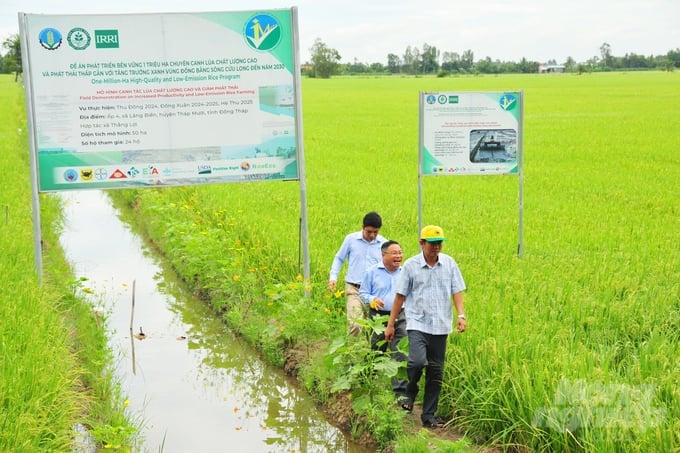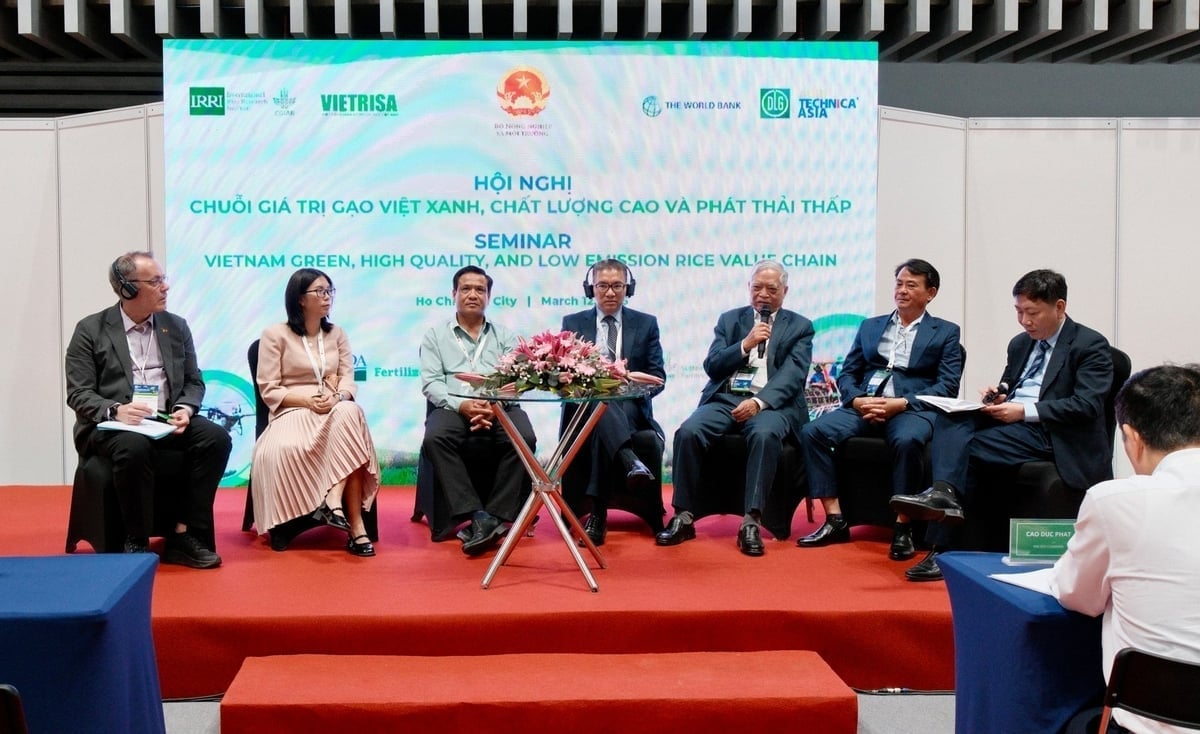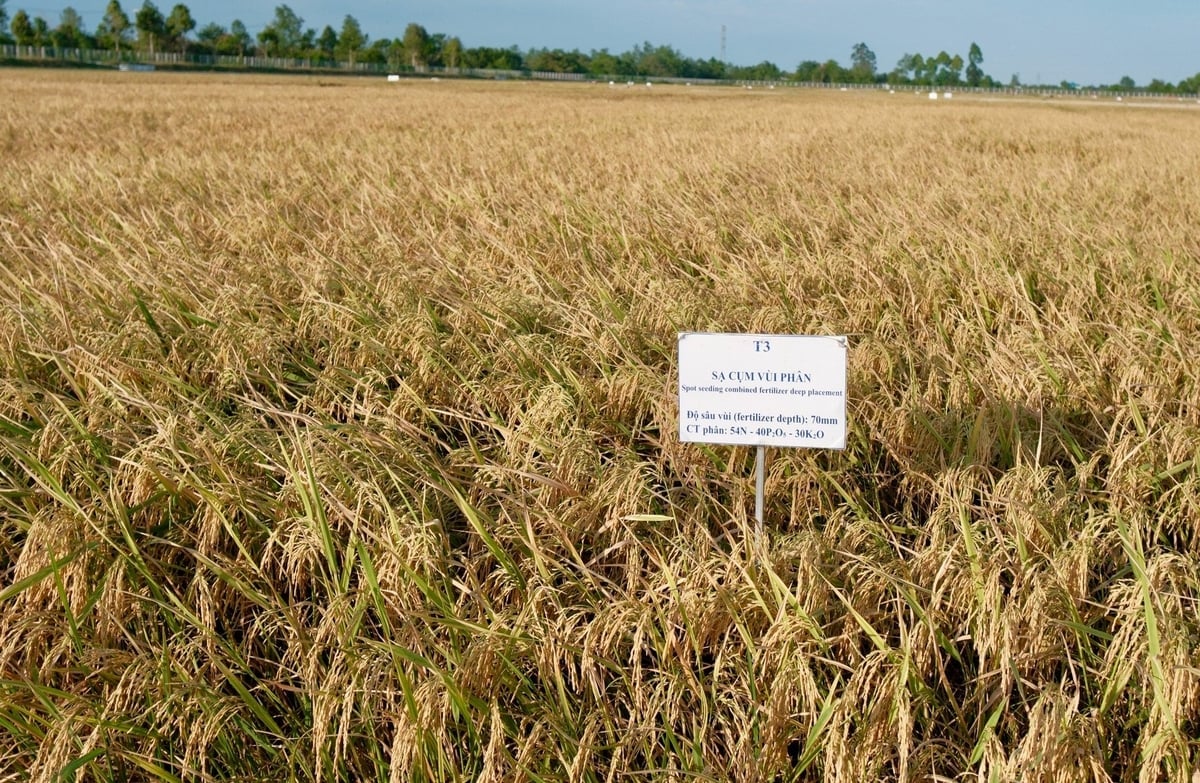November 21, 2025 | 10:32 GMT +7
November 21, 2025 | 10:32 GMT +7
Hotline: 0913.378.918
November 21, 2025 | 10:32 GMT +7
Hotline: 0913.378.918
As part of the AGRITECHNICA ASIA Vietnam 2025 International Exhibition, the Ministry of Agriculture and Environment, in collaboration with the International Rice Research Institute (IRRI), the Vietnam Rice Industry Association (VIETRISA), and the German Agricultural Society (DLG), organized the conference “Green, High-Quality, and Low-Emission Vietnamese Rice Value Chain” on March 12.
At the conference, specialists announced the latest progress in implementing the “Sustainable Development of One Million Hectares of High-Quality, Low-Emission Rice in association with Green Growth in the Mekong Delta by 2030” project (One Million Hectares Rice Project). This strategic initiative has gained international recognition and esteemed commendations.

Vietnam’s One Million Hectares of High-Quality, Low-Emission Rice project is a strategic initiative that has gained international recognition and esteemed commendations. Photo: Tung Dinh.
According to Le Thanh Tung, Standing Vice Chairman and General Secretary of VIETRISA, the association aims to develop a labeling system for green, low-emission Vietnamese rice by 2025. This approach will be stepping stone for VIETRISA to support the national branding strategy, which seeks to establish recognition for low-emission rice with carbon credit value by 2028.
Vice Chairman Le Thanh Tung explained that the One Million Hectares Rice Project has frequently referenced the concept of “low-emission rice.” While a pilot program for the measurement, reporting, and verification (MRV) system is currently underway, the full framework for payments, measurement, and pricing will not be completed until 2028.
However, the development of a green, low-emission Vietnamese rice brand can begin immediately. The process requires businesses to demonstrate strict compliance with the Technical Process for High-Quality, Low-Emission Rice Production, issued by the Department of Crop Production (now the Department of Crop Production and Plant Protection) in 2024. Accordingly, local business and farming communities engaged in low-emission cultivation will achieve effective and visible results by following the correct processes,.
“VIETRISA will be responsible for issuing certifications for green, low-emission Vietnamese rice, thereby ensuring transparency and credibility. In the absence of a national certification system for low-carbon rice, businesses can self-declare their green rice brands and take full responsibility for their claims,” Le Thanh Tung stated.
Accordingly, stakeholders will develop the low-emission rice brand at multiple levels, beginning with individual businesses. Companies participating in the One Million Hectares Rice Project must actively demonstrate the quality of their products to consumers.

The discussion took place as part of the conference on “Green, High-Quality, and Low-Emission Vietnamese Rice Value Chain.” Photo: Quynh Chi.
Nguyen Cao Khai, Director of Tien Thuan Agricultural Cooperative (Thanh An Commune, Vinh Thanh District, Can Tho City), shared that his cooperative was the first in Can Tho and the Mekong Delta to be selected for a pilot model under the One Million Hectares Rice Project. The model spans 50 hectares, with 12 participating households following low-emission farming practices and three households maintaining traditional methods for comparison.
After three crop cycles, results indicated that yields from traditional farming ranged from 8.2 to 8.4 tons per hectare, whereas yields from the low-emission model reached 8.6 to 9 tons per hectare. “The results deeply motivated our farmers, especially as rice prices are falling while input costs continue to rise. We can visibly see the economic benefits, but more importantly, we are contributing to protecting our health, our communities, and the environment,” Khai said.
Regarding production costs, traditional farming required approximately 23 to 25 million VND per hectare for seeds and fertilizers. On the other handn, the low-emission model reduced this expense to nearly 20 to 21 million VND per hectare.
Nguyen Thi Thu Huong, Deputy Director of the Department of Crop Production and Plant Protection under the Ministry of Agriculture and Environment, emphasized that fully understanding the benefits of sustainable farming will encourage farmers to actively participate and remain committed to the model for the foreseeable future.
When the One Million Hectares Rice Project first launched, it benefited from favorable market conditions, with rising rice prices. However, current rice prices have declined to levels similar to those before the increase.
Huong stated, “It is crucial to consider whether price fluctuations will affect farmers’ willingness to participate. Consequently, appropriate support mechanisms are necessary to encourage their continued adoption of sustainable practices.”

At the Cuu Long Delta Rice Research Institute, IRRI collaborates with local scientists to research and develop low-emission rice farming methods. Photo: Quynh Chi.
According to Nguyen Thi Thu Huong, production linkages in the rice sector are relatively unstable. As a result, detailed policies and solutions are required to enhance connections between farmers, businesses, and markets, which will facilitate the expansion of the low-emission rice model.
“The Vietnamese rice sector must focus on creating responsible products—not only for consumers but also for the sector’s long-term future. By establishing a strong low-emission rice brand, Vietnam can create its unique market, increase product value, and elevate the rice sector’s standing on the international stage,” Huong emphasized.
Dr. Nguyen Van Hung, Senior Expert and Head of the Mechanization and Post-Harvest Group at IRRI Vietnam, highlighted significant advancements in digital data ecosystems for rice production management. A key innovation is the RiceMoRe system, co-developed by the Department of Crop Production and Plant Protection, the Center for Digital Transformation and Agricultural Statistics, and IRRI.
According to Hung, RiceMoRe enables automated data collection at various levels, from individual farmers and cooperatives to regional and national agencies, significantly improving the quality of rice production reports and statistics. Notably, the system can store and process greenhouse gas emission data from rice farming.
“The development and application of digital technologies similar to RiceMoRe will establish a strong foundation for Vietnam’s agricultural sector as it progresses toward 2028. The goal is to promote transparency in production, enhance product value, and meet the demands of both domestic and international markets,” Dr. Hung affirmed.
To date, five provinces—Soc Trang, Can Tho, Tra Vinh, Dong Thap, and Kien Giang—have piloted the low-emission rice farming model over three crop cycles. VIETRISA will encourage businesses to acquire rice from these pilot models and label their products with a low-emission certification on the packaging.
Translated by Nguyen Hai Long

(VAN) This is the study conducted by IRRI and Can Tho University on the rice straw value chain in Mekong Delta showing an economic potential of more than 6.6 trillion VND/year.

(VAN) By participating in cooperative economics, many farmers in Tay Ninh have overcome hardship, mastered clean dragon fruit cultivation techniques.

(VAN) The crossbreeding program in the former Binh Dinh province (now part of Gia Lai) has shown signs of decline, and urgent measures are needed to revive it and sustain past achievements.

(VAN) The agricultural sector agreed on a roadmap to pilot the MRV protocol and expand low-emission rice production from the 2025-2026 winter-spring crop.

(VAN) Agricultural extension officers in Quang Ninh do more than transmit knowledge; they have become a steadfast support system for farmers on the path to sustainable agricultural development.

(VAN) The development of a high-quality beef cattle herd has brought major benefits to livestock farmers, creating jobs and enabling better use of agricultural by-products.

(VAN) In the eastern region of Gia Lai, crossbred cattle now account for 93%, forming a high-quality beef herd and establishing a recognized brand, the result of 35 years of persistent effort.